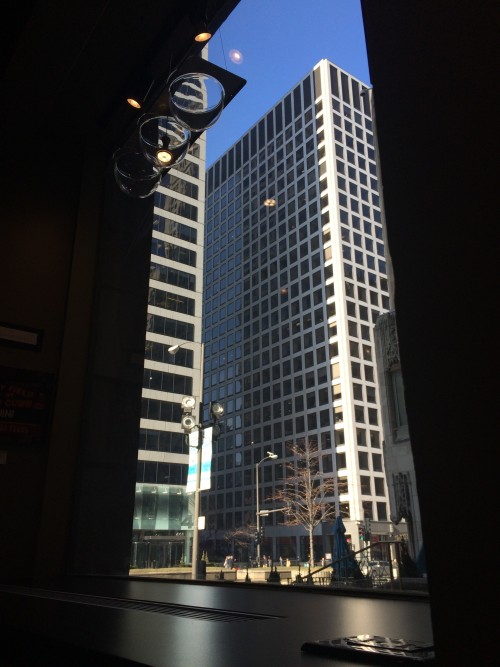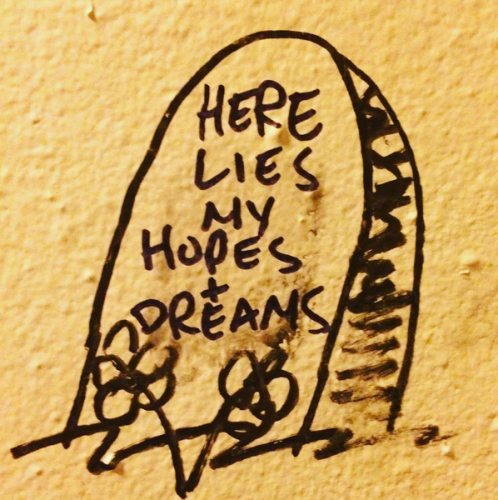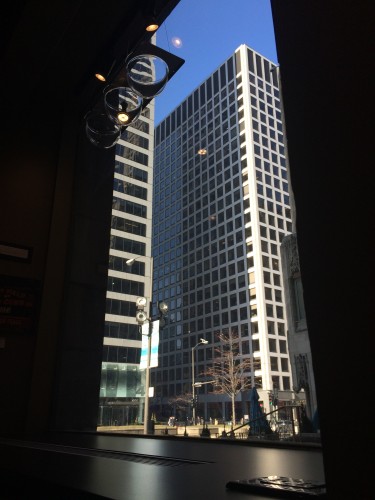
Let’s NOT Talk About Thesis

Baby otters in space, because why not? AKA procrastination space station
I know you are all probably sick of all my thesis posts, and I kind of am too. So let’s make a deal. I’ll not mention that dreaded T-word again in this one. Cool?
I’m sitting at Argo Tea on Michigan Ave, drinking a hot cup of tea whilst eating a delicious chocolate chip cookie. Apart from the baristas, I’m the only one here, and it’s nice to be so still and silent (apart from the frothing beverage machines) while the chaos of downtown passes by on foot and by car, everyone racing to get somewhere. Right now, I’m not thinking about the essay I’m halfway through. I’m thinking about the way the sun hits the building across the street from me and how the shadows fall across its façade.
It’s easy to get caught up in the frenetic pace of city life, it’s easy to become another one of those frustrated faces on the bus or the train. While this winter is not as cold as the previous two I’ve experienced here, we still complain about the cold and wonder “Why do I live in a place that makes my face hurt?”
In spite of the noise and the garbage and the trains that pull away just as you get to the platform, I’m lucky to be living here, to be reading and writing down the street from the Art Institute (which I’ll probably wander into later today), to be looking across my table into the lobby of the Tribune Tower. Not to sound like an inspirational self-help guru, but if I give myself the space and time to shut up my brain and observe, just for a moment, l realize how many amazing things are all around me and can shake off some of that that grey malaise of urban winter.

Sad bathroom graffiti. You need a hug.
Today I want to make a case for slowing down, for lazily looking. When I’m caught up in my work or neck-deep in a piece, all my thoughts lead there—either regarding the topic of the piece itself or regular ol’ anxiety about finishing it and how I might solve the questions of writing it that plague me about pacing, transitions, time frames, and everything else.
Wherever you are reading this, take one minute (and I really mean one minute; 60 seconds) and really study your surroundings. Many writers know this as an exercise to practice descriptions and get ideas flowing, but I also think it’s useful in terms of gaining (or regaining) your bearings when there is too much going on in and around you. What do you see? Hear? Smell? Feel? What things do you notice that you’ve never paid attention to before?
When I have too many ideas going on in my mind, I have a tendency to get tangled in them, and trying to untangle them is not only frustrating but sometimes it tangles things further. When I’m trapped in one of these knots I can’t focus and I can’t work. Slowing down and focusing on something as simple as the table I’m sitting at—the materials it’s made of, the texture of the surface, how it’s put together from tabletop to leg to feet—can make it a little easier to isolate all the threads I’m dealing with.
You may wonder what I’m doing with this many-threaded sewing metaphor, but bear with me. I used to do a lot of sewing when I was younger, but I was never a fan of using patterns; instead, I did a lot of my work off the cuff (ha!) hoping it would come together, much like when I’m writing an essay.
When you have all the fabric laid out on the table and you’re ready to cut out your pieces, it can be a little nerve wracking. What if I cut something too small? What if my lines are off? What if I don’t even have all the pieces I need? And once I have all the pieces, what if I sew them together incorrectly or my seams don’t hold? You have to make that first cut if you want to have that beautiful dress that you envision at the end, even if you’re not sure about which steps you need to take next.
Sound familiar?
A big part of my process involves cutting up and putting things back together again. It’s easy to get overwhelmed when you’ve got paragraphs of a 20-pager laid out on your apartment floor, wondering how you’re going to put it all together again. You might stitch two pieces together and realize it was all wrong. You might realize you have extra material that simply isn’t needed. You might find you need more of something else you don’t have before you.
For me, getting off the computer is a method of slowing down, of reconnecting with the nondigital world. When I’m cutting up an essay, I’m not reading the words, I’m really just cutting the paper and putting the pieces on the floor. I’m thinking about the precision of my lines, if there’s enough room on the floor. I’m kneeling, my face is inches away from the wood planks of my apartment floor, so close that I can see the small gaps between each plank and the grain of the wood. I see the scuffs and the scratches and the footprints of everyone who has walked on this floor before me.
No matter what you’re working on, we can all benefit from taking a peek out the window or a moment to study what is right next to you. Who knows what you might discover?

My view
